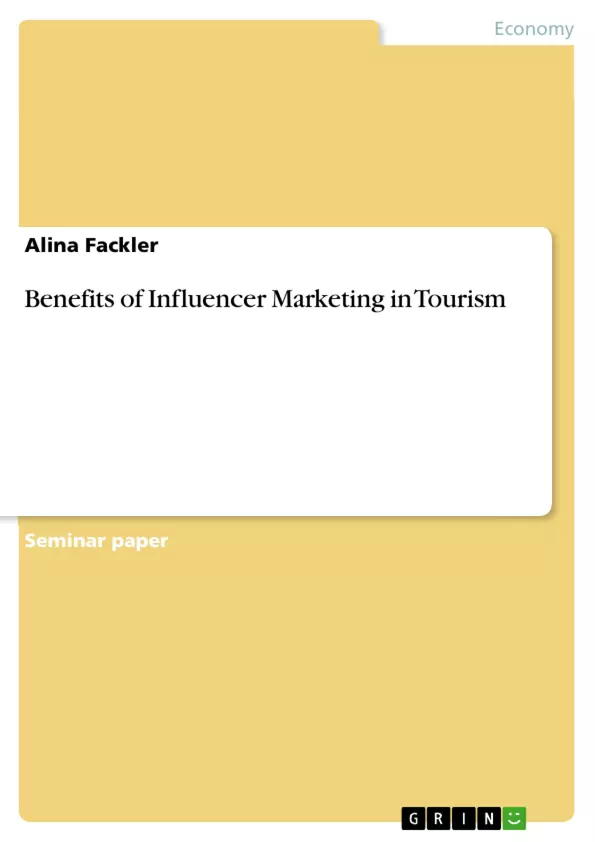Nowadays, it is a decisive role for the image of a company to be represented on social media because it is one of the most important type of media in today’s time. The influence of traditional media is declining sharply. Companies thus loose the opportunity to reach their target groups via these older communication channels. At the same time, almost 80% of adults are online and are spending daily 166 minutes on average in the web. Consumers look at other consumers to inform themselves about products and services. This is why a new segment of Marketing has developed: so called Influencer Marketing. It is a trend topic and many companies deal already with it.
Many tourism companies agree that Marketing of their offers is mostly online. But customers do not exclusively inform themselves online. Word of mouth from family and friends are still worth a lot. Consequently, the tourism companies cannot compete with personal relations. Nevertheless, there is an opportunity to work with bloggers and thus imitate the personal recommendation. Most tourism experts are already actively using social media and look, above all opportunities, for stronger customer loyalty, direct contact with customers, but also for addressing new target groups.
The aim of the present work is to define Influencer Marketing and to work out the benefits for the tourism industry.
Inhaltsverzeichnis (Table of Contents)
- 1 OBJECTIVES AND STRUCTURE OF THE WORK
- 1.1 Objectives and structure of the work
- 2 INTRODUCTION
- 3 METHODOLOGY
- 4 FUNDAMENTALS OF INFLUENCER MARKETING
- 4.1 Definition Influencer and Influencer Marketing
- 4.2 Development of Influencer Marketing
- 4.3 Contact and procedure of Influencer Marketing
- 4.4 Social media channels used for Influencer Marketing
- 5 INFLUENCER MARKETING IN TOURISM
- 5.1 Social Media Platforms in Tourism
- 5.2 Examples of successful Influencer Marketing in Tourism
- 5.3 Benefits and risks of Influencer Marketing
- 5.3.1 Benefits of Influencer Marketing in Tourism
- 5.3.2 Risks of Influencer Marketing
- 6 FUTURE PERSPECTIVE
- 7 CONCLUSION
- 8 BIBLIOGRAPHY
Zielsetzung und Themenschwerpunkte (Objectives and Key Themes)
This work aims to define Influencer Marketing and to explore its benefits for the tourism industry. It examines the concept of influencers, the development of influencer marketing, and the social media channels used in this marketing strategy. The work then delves into the application of influencer marketing in the tourism sector, analyzing its advantages and risks.
- Definition and development of Influencer Marketing
- Social media platforms used for Influencer Marketing
- The benefits and risks of Influencer Marketing in Tourism
- Examples of successful Influencer Marketing campaigns in Tourism
- Future perspective of Influencer Marketing in Tourism
Zusammenfassung der Kapitel (Chapter Summaries)
- Chapter 1: Objectives and Structure of the Work: This chapter provides an overview of the work's structure, outlining its key objectives and how the research is organized.
- Chapter 2: Introduction: This chapter contextualizes the research by discussing the changing marketing landscape, the increasing importance of online presence, and the emergence of Influencer Marketing as a key strategy.
- Chapter 3: Methodology: This chapter outlines the research methods used in the work, focusing on the sources of information used to gather data about Influencer Marketing.
- Chapter 4: Fundamentals of Influencer Marketing: This chapter delves into the definition of influencers and influencer marketing. It explores different types of influencers, the development of influencer marketing as a communication tool, and the various social media channels used for influencer marketing.
- Chapter 5: Influencer Marketing in Tourism: This chapter examines the application of influencer marketing within the tourism industry. It explores the reasons for its increasing importance in this sector, analyzes various social media platforms used in tourism, and provides examples of successful influencer campaigns. It also discusses the benefits and risks associated with this marketing strategy.
- Chapter 6: Future Perspective: This chapter analyzes the future of influencer marketing in tourism, considering its potential impact on the industry and the development of this strategy.
Schlüsselwörter (Keywords)
The main keywords and focus topics of this work are: Influencer Marketing, tourism, social media, digital marketing, online marketing, customer engagement, brand awareness, content marketing, social media platforms, Instagram, Facebook, YouTube, travel influencers, and influencer campaigns.
- Citation du texte
- Alina Fackler (Auteur), 2018, Benefits of Influencer Marketing in Tourism, Munich, GRIN Verlag, https://www.grin.com/document/419895



